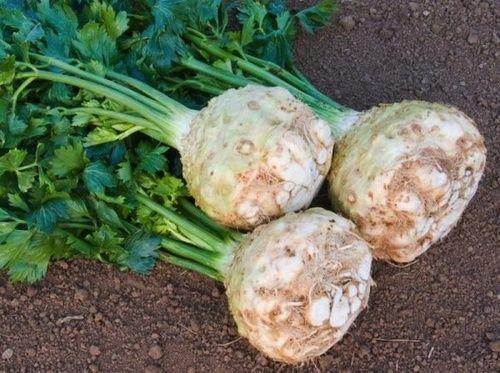Il Celeriac (Apium graveolens var. Rapaceum) belongs to the Umbelliferae family. Provides a reduced calorie intake and has diuretic properties and depurative thanks to the essential oils it contains. Let's find out better.
> Nutritional characteristics
> How to use it

Description of celeriac
Celeriac it is a vegetable grown in particular in the north of the country (in fact it is better known as celery from Verona), while in the south it is little known.
Celeriac has a root brown on the outside and white on the inside, with a globular and gnarled shape. The leaves, on the other hand, are dark green and the stems are hollow inside. The overall appearance is uninviting but this is well compensated by its mild flavor.
This plant has a two-year cycle and the harvest takes place from the end of August and lasts until December or in any case until the first frosts begin.
Calories and nutritional values of celeriac
Celery contains 23 Kcal per 100 g of product and consists of a considerable amount of water (about 88%).
In addition, celeriac root contains carbohydrates, proteins, fats, lots of fiber and a good amount of antioxidant vitamins and minerals. mineral salts, such as iron, potassium and manganese.
Properties of celeriac
Celeriac has a rather strong aroma, due to the presence of a essential oil, From 'diuretic and purifying action.
Celeriac has remineralizing properties, being rich in: selenium, calcium, iron, phosphorus, iodine, magnesium, manganese, potassium, copper, sodium. It also contains vitamin A, vitamins of the B complex and vitamin C. Among its properties, we also mention tonic, expectorant and digestive action.
For this reason celeriac is recommended for people with digestive difficulties, in case of asthenia and to recover during a convalescence.
It is good to know, however, that, due to the presence of some proteins, celeriac is a food potentially allergenic for those sensitive and predisposed to food allergies.
Learn about the causes and remedies of difficult digestion

How celeriac is used
Celeriac is a vegetable most exploited inculinary field than therapeutic. In fact, it finds its use in the kitchen in the preparation of salads, therefore it is eaten raw, where the properties of the plant's essential oils help purify the organism from waste, favoring diuresis.
Celeriac can, however, also represent a healthy side dish if cooked in the oven au gratin, in a pan with breadcrumbs or added to soups and broths. It is advisable to buy celeriac when it reaches a weight ranging from 600 to 700 grams: this represents the ideal weight that reflects the quality of the product.
READ MORE
Like celeriac, pilosella also has diuretic properties. Discover all the others
Other articles on celeriac:
> Celeriac among the February vegetables
> How to cook celeriac: quick and easy recipes
> 5 ways to make the most of celeriac root
| Saemereien.ch


























